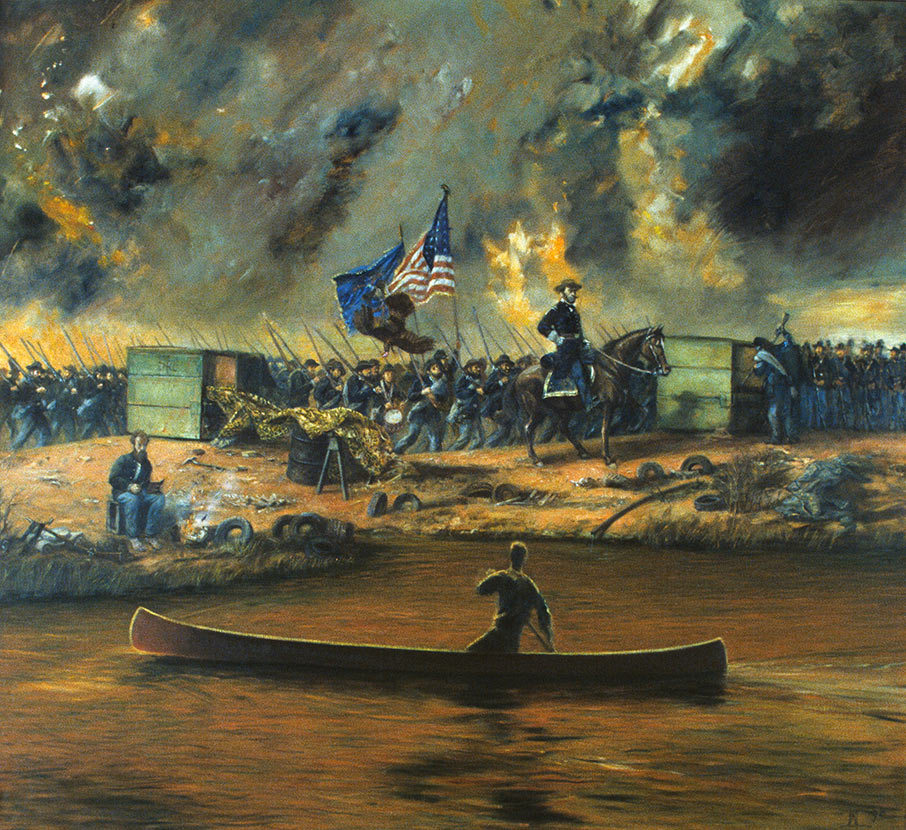Sherman Marches South by Manning Williams is my favorite painting in the Gibbes Collection. A man in a canoe paddles up a still creek as the Division of the Mississippi marches by. Above and behind the mass of Union soldiers, flames and dark clouds swirl hellishly.
Manning Williams was a Civil War buff who could have swapped facts with Shelby Foote, but Sherman is anachronistic. The riverbank is littered with car tires, and—what really makes the painting—two Army-green garbage dumpsters are front and center, like squat columns on which the entire giant work rests.

When we bring students into the Gibbes to write about art, we always ask them to incorporate a smell into their stories. (Usually it’s a piece like Jill Hooper’s Self-Portrait or Robert Henri’s The Green Fan with no obvious odor like a fire or garbage.) Smell is a sense rarely conveyed through the arts, rarely written or painted or sung about. Mussorsgy didn’t write a piano composition called “Odors at an Exhibition.”
War is a subject often romanticized. Even when painters and writers and filmmakers try to convey the horrors of it, it can ultimately have a romantic effect. Whatever thing a soldier in 1864 would have thought as dismal, banal, smelly and awful as a wartime garbage dumpster, we likely now see as historic, antique, with any offensive odor Febrezed out of it. The dumpsters translate the awfulness into the present. It’s a little like when historians explain that the Louisana Purchase cost $250 million in today’s dollars. It’s the same reason director Baz Luhrman used Jay-Z hip-hop in The Great Gatsby. Williams’ surreal anachronism of the dumpsters overcomes the romance that art and history can so easily create.
We all romanticize the past. Our entire tourist economy here in Charleston is built on it. But when you stay in a historic bed and breakfast south of Broad, you’re nostalgic for the movie about life in the 1700s, not actual life in the 1700s. The smell would stop you in your tracks. Nobody romanticizes the lack of refrigeration, running water, the bathroom situation or slave auctions. It’s fine to ‘step back in time,’ as long we remember we’re really peering through a jasmine-scented haze of bespoke cocktails.
Slavery and the Civil War, of course, are not dead today. They still smolder like a dumpster fire. Nine members of Emmanuel AME church were shot by a man espousing the racist beliefs of the Confederacy, but we still can’t completely decide as a country what the war was fought over (or even what to call it). In the aftermath of the Emmanuel 9 shooting, Yale University has decided to rename Calhoun College because of John C. Calhoun’s defense of slavery. Meanwhile Emmanuel church members, including survivors, still attend services at 110 Calhoun St., a block from his towering statue. There’s been no movement here to change the name of the street.
In Manning’s painting, a Union soldier is cramming something in a dumpster with his bayonet. For most Americans, it’s best to contain the Civil War in a box. Some prefer not to think about it as something still living and present. Some, of course, prefer to poke away at it forever. (My bookstore once had an entire shelf of books on just Appomattox, and that’s only a fraction of what’s out there.)

It’s been said that air conditioning changed the South as much as the Civil War. I don’t know how to quantify that argument, but I am a big believer in the extraordinary impact of ordinary things. Who had a greater influence on the South, William Tecumseh Sherman or Martin Luther King? King died in Memphis while protesting with sanitation workers. We are always quick to thank our troops but less so the people who haul our trash away every week. Which would affect your life more, a military strike or a sanitation strike?
Perhaps thousands of people have walked through the galleries and paused before Sherman Marches South. Perhaps many history buffs have spotted some interesting detail, surmised that one figure is Col. George Spencer, who rode with Sherman.
I wonder if at least once, some expert in waste management has looked closely at those dumpsters and thought, “You don’t see the SC405 much anymore.”
Of course, centuries from now, maybe someone will look at the garbage, the fire, the bayonets, and view them all as relics of the same lost era.
—Jonathan Sanchez, guest blogger
Jonathan Sanchez is the owner of Blue Bicycle Books and the director of Write of Summer, a writing camp for kids. He’s brought students into the Gibbes for years to write poems and stories about the paintings. He regrets to admit that he made up the model number of the dumpster.
Top image: Sherman Marches South (detail), 1990, by Manning Bethea Williams Jr. (American, 1939–2012)
Published March 7, 2017

